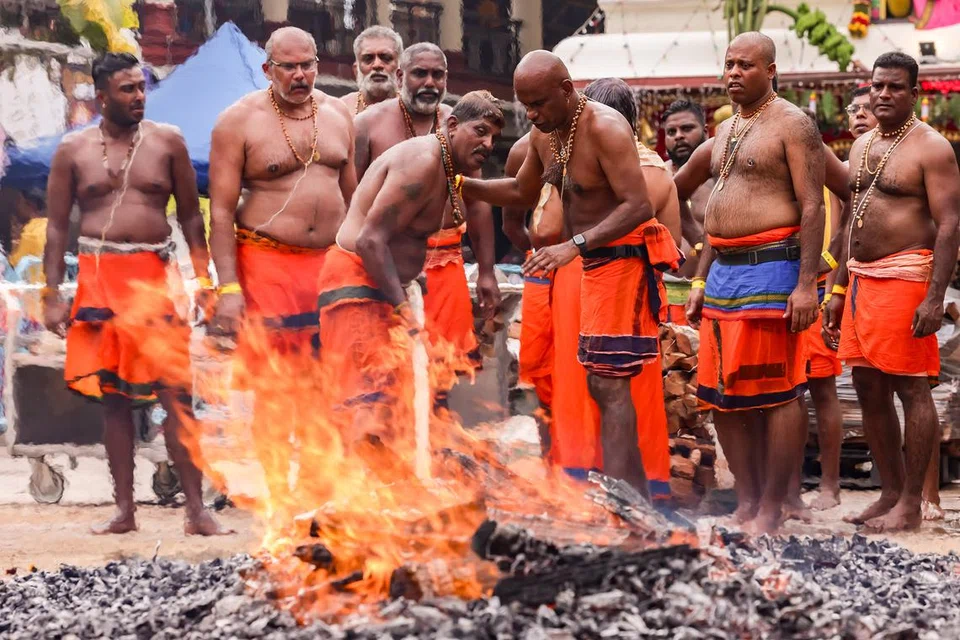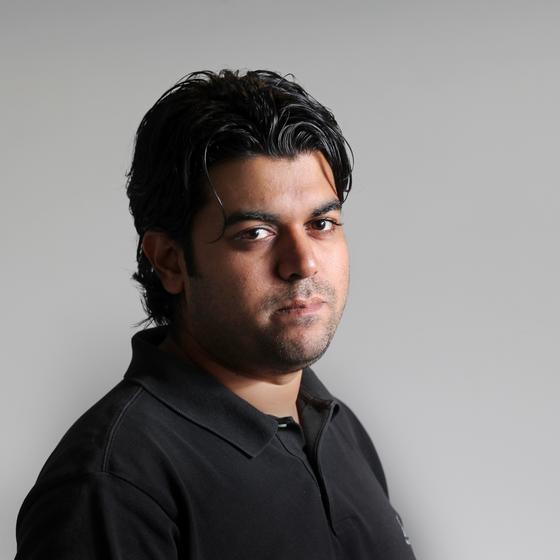When I arrive at Sri Mariamman Temple in South Bridge Road around 4pm last Sunday, bare-chested volunteers decked in orange dhoti (cloth worn around the waist) are hosing down the temple walls to keep it cool.
Looking at some of the spectators perspiring in the makeshift stands surrounding the temple’s quadrangle, it seems some of them could use a cooling down as well.
Metres away from a burning fire pit, devotees arrive at Sri Mariamman – Singapore’s oldest Hindu temple founded in 1827 – as early as 2pm. They are there to witness Theemithi, a fire-walking ceremony where devotees walk barefoot on burning embers as a form of penance or thanksgiving to the goddess Sri Drowpathai Amman.
The fire pit has been burning since just after sunrise. More than 22,000 pieces of wood – added layer after layer – are being used for the pit, measuring 18 feet (5.4m) in length to symbolise the 18 days of the war between two royal families in the Sanskrit epic, Mahabharata.
The festival re-enacts episodes from the Mahabharata, which include recitals of chapters in Tamil. Preparations typically begin weeks before – with a flag-hoisting ceremony – and culminates in the fire-walking event, which usually takes place on a Sunday, a week before Deepavali.
The fire walk, however, is traditionally for males only, although pre-event ceremonies – such as the carrying of milk pots, prostrations and rolling on the temple floor while engaged in prayer – are open to both men and women.
By 6pm, the stands on the north and east sides of the temple are packed to the rafters. Crowds have also formed on the ground level behind barriers as everyone awaits the arrival of the chief priest, who is making the 4km-walk from Sri Srinivasa Perumal Temple in Serangoon Road with an entourage in tow and a sacred vessel – or karagam – consisting of rice, lemon and a gold coin, atop his head.
The man of the hour arrives on time, with Minister for Culture, Community and Youth Edwin Tong in his company. Curiously, Mr Tong isn’t the only Chinese individual at the temple – there are a handful of Chinese devotees too participating in the ceremony.
“Om Shakti! Om Shakti!”, the crowd chants as the priest prepares for his walk of faith. He does a dance while balancing the karagam on his head, smiles as he stares at the pit, and walks – without too much of a rush – across the burning ashes. The crowd cheers.
The devotees then make their trek across the pit. Their methods and mannerisms vary.
Some of them prostrate in front of the fire pit before walking, others simply close their eyes and mutter a prayer to themselves. Some raise their hands up as they walk, others run. Some of them dip their feet into the milk pit at the end of the stretch, some simply hop across the pool.
“You feel the heat on the soles, but once you cross and step into the milk, the burning sensation ceases,” explains Mr V. Thilak, who is seated next to me in the stands.
The 44-year-old Singaporean is a spectator today, but he lets me know rather proudly the number of times he’s done the fire-walk.
“I’ve fire-walked six times; my first time, I was 18,” he tells me. “There’s a mixed feeling of fear and elation as you are about to do it.
“One time, it did hurt quite a bit. I walked around the temple just so I could feel the sensation return to my feet. I had very mild burns and blisters after that, but I applied turmeric paste and it was fine after two days.”
Has anyone ever been seriously hurt before? I ask him.
“Well, that’s why there are first-aid stations right outside the temple,” he replies.
And has anyone ever tripped and fell on the heap of burning embers?
Mr Thilak nods. “But they are alert to such things,” he says, pointing to the volunteers standing along the breadth of the fire pit. “If someone falls, they are very quick to help the person up.
“But as a devotee, you mustn’t borrow grief from the future. The act is about faith. You must have it before and as you walk.”


